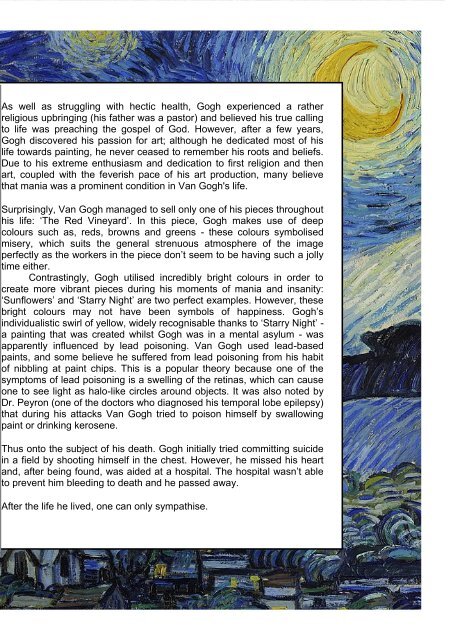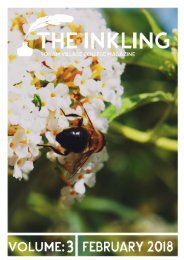The Inkling Volume 2
Create successful ePaper yourself
Turn your PDF publications into a flip-book with our unique Google optimized e-Paper software.
As well as struggling with hectic health, Gogh experienced a rather<br />
religious upbringing (his father was a pastor) and believed his true calling<br />
to life was preaching the gospel of God. However, after a few years,<br />
Gogh discovered his passion for art; although he dedicated most of his<br />
life towards painting, he never ceased to remember his roots and beliefs.<br />
Due to his extreme enthusiasm and dedication to first religion and then<br />
art, coupled with the feverish pace of his art production, many believe<br />
that mania was a prominent condition in Van Gogh's life.<br />
Surprisingly, Van Gogh managed to sell only one of his pieces throughout<br />
his life: ‘<strong>The</strong> Red Vineyard’. In this piece, Gogh makes use of deep<br />
colours such as, reds, browns and greens - these colours symbolised<br />
misery, which suits the general strenuous atmosphere of the image<br />
perfectly as the workers in the piece don’t seem to be having such a jolly<br />
time either.<br />
Contrastingly, Gogh utilised incredibly bright colours in order to<br />
create more vibrant pieces during his moments of mania and insanity:<br />
‘Sunflowers’ and ‘Starry Night’ are two perfect examples. However, these<br />
bright colours may not have been symbols of happiness. Gogh’s<br />
individualistic swirl of yellow, widely recognisable thanks to ‘Starry Night’ -<br />
a painting that was created whilst Gogh was in a mental asylum - was<br />
apparently influenced by lead poisoning. Van Gogh used lead-based<br />
paints, and some believe he suffered from lead poisoning from his habit<br />
of nibbling at paint chips. This is a popular theory because one of the<br />
symptoms of lead poisoning is a swelling of the retinas, which can cause<br />
one to see light as halo-like circles around objects. It was also noted by<br />
Dr. Peyron (one of the doctors who diagnosed his temporal lobe epilepsy)<br />
that during his attacks Van Gogh tried to poison himself by swallowing<br />
paint or drinking kerosene.<br />
Thus onto the subject of his death. Gogh initially tried committing suicide<br />
in a field by shooting himself in the chest. However, he missed his heart<br />
and, after being found, was aided at a hospital. <strong>The</strong> hospital wasn’t able<br />
to prevent him bleeding to death and he passed away.<br />
After the life he lived, one can only sympathise.




